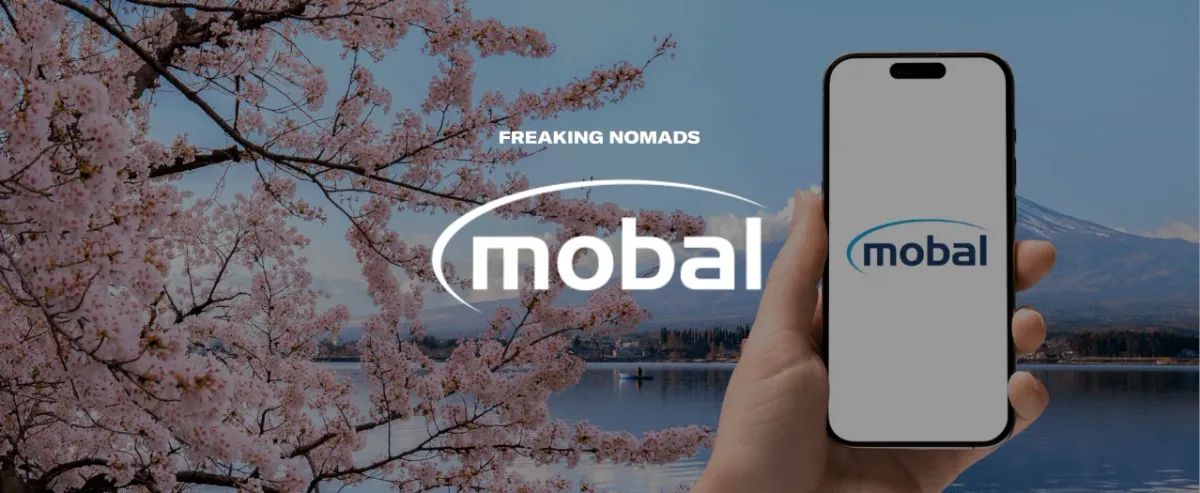Mobal Review: The Best eSIM with a Local Number for Japan?

Before my trip to Japan, people kept warning me that getting mobile service there is a nightmare. Everything’s in Japanese, and most eSIMs don’t even give you a local number, which you actually need for a lot of things.
I braced myself for the worst... until I heard about Mobal. This eSIM provider offers the only native Japanese eSIM with reliable data as well as a real Japanese number to both short and long-term travelers.
In this guide, I’ll break down everything you need to know about this eSIM: how it works, what plans they offer, how it performed for me, and why it might be worth checking out if you are planning to travel to Japan.
What's Mobal’s Japan eSIM?
Mobal is a long-standing telecom provider that has been keeping travelers and digital nomads connected in Japan since 1989, with over half a million customers so far.
They offer everything from data-only plans for short trips to Voice + Data plans that come with a real Japanese number, and even pocket WiFi if that's your thing.
What makes Mobal different is that it was built by English speakers who actually live in Japan. They know the exact pain points foreigners run into, like strict registration rules or not being able to get a local number, and they built their service to solve them.
Unlike international eSIMs that just “happen” to work in Japan, Mobal gives you a true Japanese eSIM. That means stronger coverage, no speed throttling, and a local number you can actually use for daily life.
How is Mobal Different from Other Japanese eSIMs?
There are certainly eSIM alternatives to Mobal for Japan, but this is what made me choose Mobal over other providers:
You get a real Japanese phone number
Mobal is the only eSIM that gives you a real Japanese phone number, and I didn’t realize how essential that was until I got there. I needed it to sign up for Uber Eats, bike-share apps like Hello Cycling and Luup, and even book taxis and rental cars. Most restaurants and concert venues also ask for a local number to confirm bookings. Without one, I would’ve missed out more than once!
Reliable coverage wherever you go
I used Mobal while traveling around Tokyo, Kyoto, Fukuoka, and even some rural towns in Hokkaido, and I never had to worry about coverage or speed. Since it runs on either NTT Docomo’s or SoftBank's network, Japan’s two biggest carriers with 99% population coverage, you get fast and stable data everywhere. And because it’s a native Japanese SIM, there are no weird slowdowns like you get with global eSIMs.
Flexible packages for any kind of trip
One thing I really appreciated was how flexible Mobal’s plans are. Since I was staying in Japan for a while, I went with the Voice + Data option. It gave me a Japanese number, plus enough data each month to get by without thinking twice. But if you’re just visiting short-term, they’ve got 8-, 16-, or 31-day plans that come with up to 100GB.
You can still use the Voice products too, since there's no contract involved. And because the first calendar month is pro-rated, you only pay for the days you use, which ends up being a great deal even for a quick stay.
Foreign-friendly setup and customer support
I don’t speak Japanese, so I was honestly expecting the setup to be a hassle. But Mobal makes it surprisingly simple. Everything, from ordering to uploading my ID, is in plain English. When I had a small issue with my activation, I sent a message to their customer support (also available in English!) on Mobal's website and got a helpful reply within a few hours. No confusing instructions or language barrier!
You’re helping just by using it
One of the unexpected things I learned about Mobal is that all of their profits go to charity. While I was just using my phone like normal, I was actually helping fund school meals and support poverty relief programs, especially in Malawi. They even run a non-profit coffee company in Tokyo that sells Malawian coffee to help support these programs. Just by choosing Mobal, you're already contributing to something good.
Which Plans Does Mobal eSIM Offer and How Much Do They Cost?
Mobal keeps things pretty simple. You’ve got two main options:
- Tourist plans: Best if you’re just in Japan for a short stay.
- Long-term plans: Better value if you’re sticking around longer or need a Japanese number for work, bookings, or local apps.
Tourist plans
These are for travelers who want flexible data options without long-term commitments. You can pick between data-only or voice + data:
| Plan | Duration | Data | Price |
|---|---|---|---|
| Data Only | 8 days | 3 GB | ¥2,340 (~US $15.91) |
| 8 days | 10 GB | ¥2,750 (~US $18.70) | |
| 8 days | 30 GB | ¥3,200 (~US $21.76) | |
| 16 days | 10 GB | ¥3,300 (~US $22.44) | |
| 16 days | 50 GB | ¥3,900 (~US $26.52) | |
| 16 days | 100 GB | ¥6,500 (~US $44.20) | |
| 31 days | 10 GB | ¥3,850 (~US $26.18) | |
| 31 days | 50 GB | ¥4,900 (~US $33.32) | |
| 31 days | 100 GB | ¥8,000 (~US $54.40) | |
| Voice + Data | per calendar month | 500 MB | ¥990 (~US $6.73) |
| per calendar month | 1 GB | ¥1,650 (~US $11.22) | |
| per calendar month | 5 GB | ¥3,190 (~US $21.69) | |
| per calendar month | 10 GB | ¥3,630 (~US $24.68) | |
| per calendar month | 30 GB | ¥4,378 (~US $29.77) |
Long-term plans
Since I was staying in Japan for a while, I went with one of the long-term plans, and for me, it was the best value:
| Plan | Duration | Data / Voice | Price |
|---|---|---|---|
| Voice + Data | Monthly | eSIM setup fee | ¥2,970 (~US $20.20) |
| Monthly | 1 GB | ¥1,650 (~US $11.22) | |
| Monthly | 5 GB | ¥3,190 (~US $21.69) | |
| Monthly | 10 GB | ¥3,630 (~US $24.68) | |
| Monthly | 30 GB | ¥4,378 (~US $29.77) | |
| Voice Lite | Monthly | eSIM setup fee | ¥2,970 (~US $20.20) |
| Monthly | Incoming calls + SMS only | ¥990 / month (~US $6.73) |
At first glance, other top eSIM providers like Airalo might look cheaper than Mobal, but that’s because it’s data-only. If you need calls, texts, or a Japanese number, you’ll end up paying extra elsewhere.
Holafly, on the other hand, offers unlimited data but charges a premium for it, and still doesn’t include a local number. That said, if you already have a data-only eSIM and just a number, Mobal does offer a separate Voice Lite eSIM you can add on, as long as your phone number supports dual eSIM. Handy if you realize after the fact that you need to receive calls or texts.
Overall, for most travelers, Mobal gives you plenty of data, better flexibility, and better value overall compared to popular eSIM providers.
How Good is Mobal eSIM? My Experience Using It in Japan
I used Mobal during a one-month trip around Japan, and it just worked.
I picked up my activation code at Narita Airport, and by the time I grabbed my bag, I was already setting things up. I followed a few simple prompts, and the eSIM was live in under 10 minutes. Most importantly, everything was in English!
Coverage was solid the entire trip. In Tokyo, I was streaming music on the subway without a single hiccup. In Kyoto, I used it mainly for Google Maps and it loaded instantly, even in quieter temple areas. Fukuoka and the small towns in between were a little slower but still totally reliable.
One moment that stood out: I booked a dinner at a local spot in Kyoto through a Japanese-only site that required a local number to confirm. Mobal made that possible and that's where I realized the value I was getting. Same thing when I needed a delivery dropped off and the driver called me directly. No local number = no delivery in Japan (literally!), so that alone made it worth it.
The only small hiccup was at Kansai Airport, where speeds dropped to around 2 Mbps for an hour or two. Not a big deal, but worth mentioning if you're planning to do anything data-heavy during transit.
Mobal eSIM genuinely made my trip to Japan smoother. No carrying pocket WiFi, no stressing about where to buy a SIM once you land. Just a working connection, right out of the gate.
Would I use it again? Definitely. And I had to list the pros and cons, this it what I would say:
Mobal eSIM Pros and Cons
How Can I Order and Set Up a Mobal eSIM?
Setting up Mobal is much simpler than I expected. I managed to do almost everything online before even landing in Japan. Here's how it works:
1. Check if your phone supports eSIMs
Most modern phones do, but you can quickly check on Mobal’s website. If not, you can go for a physical SIM instead.
2. Choose your plan
Pick between a short-term data-only plan or a voice + data plan with a real Japanese number.
3. Verify your ID
Japanese regulations require ID verification, but Mobal makes it easy. Everything is in plain English, and you’ll get a personal code to complete activation.
4. Get your pickup code
You can either receive it by mail before your trip or collect it in person at one of their 24+ pickup points, including airports, train stations, and stores. I picked mine up at Narita Airport in minutes!
5. Activate your eSIM
Once you’ve got your code, head to Mobal’s activation page, confirm your plan, and make the payment.
6. Install and go
Follow their step-by-step install guide (it’s super simple), and you’ll be online in a few taps.
Mobal eSIM vs Pocket WiFi: Which One Should You Get?
Pocket WiFi has been the go-to in Japan for ages, since getting a SIM card as a tourist is usually a huge pain. You often need a local address, a long-term contract, or have to navigate confusing paperwork in Japanese. Pocket WiFi is the workaround: you can book it online, pick it up at the airport, and you’re good to go. Super convenient.
But Mobal’s Pocket WiFi works a little differently. For starters, it’s not a rental. You actually own the device (it costs ~ US $40 upfront), which means you can reuse it for future trips to Japan, or even use it in other countries by popping in your own SIM card. It has a SIM slot built in, which is a nice bonus for nomads.
Here’s how it works:
You pay ¥6,980 (~ US $40) for the device upfront. After that, you can choose between:
- 100 GB/month for ¥4,980 (~ US $34)
- 200 GB/month for ¥5,980 (~ US $40)
- 300 GB/month for ¥6,980 (~ US $47)
It runs fast (up to 150 Mbps download and 50 Mbps upload) and you can connect up to 10 devices at the same time. That’s plenty for your phone, laptop, tablet, or sharing with friends.
Mobal's Pocket WiFi comes with a 12-hour battery, a small 2.4” screen, charges via USB-C, and fits in your palm (it only weighs 130g). There’s a 300 GB/month soft cap, and even after that, your connection doesn’t cut off, it just slows down to 384 kbps.
Ready to Try Mobal eSIM?

Join our global
digital nomad community
Join us for free
Freaking Nomads is supported by you. Clicking through our links may earn us a small affiliate commission, and that's what allows us to keep producing free, helpful content. Learn more





 Travel tips, hacks, and news
Travel tips, hacks, and news Exclusive travel discounts
Exclusive travel discounts Offers and promotions
Offers and promotions Digital nomad inspiration
Digital nomad inspiration Latest articles form our blog
Latest articles form our blog